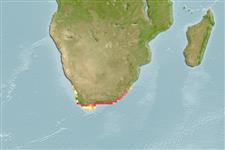Ελασμοβράγχιοι (καρχαρίες και σαλάχια) (sharks and rays) >
Carcharhiniformes (Ground sharks) >
Triakidae (Houndsharks) > Triakinae
Etymology: Triakis: tri-, from tres (L.), three; akis (Gr.), point, referring to each tooth consisting of one large central cusp flanked on by both sides by a small cusplet. (See ETYFish); megalopterus: mega-, from megas (Gr.), large; pterus (Gr.), fin, referring to its broad, large fins. (See ETYFish).
More on author: Smith.
Environment: milieu / climate zone / depth range / distribution range
Οικολογία
Θαλασσινό(ά) βενθικό(ς); εύρος βάθους 1 - 50 m (Ref. 5578). Subtropical; 30°S - 36°S
Southeast Atlantic: Namibia to Coffee Bay, South Africa.
Length at first maturity / Μέγεθος / Βάρος / Age
Maturity: Lm 145.0, range 140 - 150 cm
Max length : 142 cm TL αρσενικό/απροσδιόριστο; (Ref. 244); 174.0 cm TL (female); μεγ. δημοσιευμένο βάρος: 20.0 kg (Ref. 5485)
Ραχιαίες άκανθες (συνολικά): 0; Μαλακές ραχιαίες ακτίνες (συνολικά): 0; Εδρικές άκανθες 0; Μαλακές εδρικές ακτίνες: 0. Blunt snout and a large mouth with small pointed teeth; caudal peduncle short and heavy (Ref. 5578). Grey with numerous black spots which may be sparse or absent in some specimens; new born pups with fewer black spots compared to adults (Ref. 5485); white below (Ref. 5578).
Occurs off sandy beaches, rocky shores and in shallow bays (Ref. 5578). Feeds on crabs, lobsters, bony fish and small sharks (Ref. 5578). Ovoviviparous (Ref. 50449). Forms schools in summer (Ref. 244). Hardy and keeps well in captivity (Ref. 244). Commonly caught by rock and surf sports anglers but not eaten much (Ref. 244). Meat is dried into shark 'biltong' or jerky which commands a relatively high price (Ref. 244). Attains 160 cm, TL (Ref. 36731).
Ovoviviparous, embryos feed solely on yolk (Ref. 50449), with 6 to 12 young in a litter (Ref. 244). 30-32 cm at birth (Ref. 244).
Compagno, L.J.V., 1984. FAO Species Catalogue. Vol. 4. Sharks of the world. An annotated and illustrated catalogue of shark species known to date. Part 2 - Carcharhiniformes. FAO Fish. Synop. 125(4/2):251-655. Rome: FAO. (Ref. 244)
IUCN Red List Status (Ref. 130435)
Threat to humans
Harmless
Human uses
αλιεία: περιορισμένης εμπορικότητας; αλιεία αναψυχής: ναί; Ενυδρείο: Δημόσια ενυδρεία
Περισσότερες πληροφορίες
Age/SizeΑύξησηLength-weightLength-lengthLength-frequenciesΜορφομετρίαΜορφολογίαΠρονύμφεςΔυναμική προνυμφώνΣτρατολόγησηΑφθονίαBRUVS
ΑναφορέςΥδατοκαλλιέργειεςΠροφίλ υδατοκαλλιέργειαςΣτελέχοιΓενετικήElectrophoresesΚληρονομικότηταΑσθένειεςΜεταποίησηNutrientsMass conversion
ΣυνεργάτεςΦωτογραφίεςStamps, Coins Misc.ΉχοιΣιγκουατέραΤαχύτηταΚολυμβητικός ΤύποςΕπιφάνεια βραγχίωνOtolithsΕγκέφαλοιΌραση
Εργαλεία
Special reports
Download XML
Διαδικτυακές πηγές
Estimates based on models
Preferred temperature (Ref.
123201): 15.8 - 22.4, mean 19.3 °C (based on 26 cells).
Phylogenetic diversity index (Ref.
82804): PD
50 = 0.5312 [Uniqueness, from 0.5 = low to 2.0 = high].
Bayesian length-weight: a=0.00240 (0.00110 - 0.00521), b=3.14 (2.96 - 3.32), in cm total length, based on LWR estimates for this (Sub)family-body shape (Ref.
93245).
Τροφικό Επίπεδο (Ref.
69278): 4.0 ±0.5 se; based on diet studies.
Ελαστικότητα (Ref.
120179): Πολύ χαμηλό, ελάχιστος χρόνος για διπλασιασμό πληθυσμού > 14 έτη (Fec=6).
Fishing Vulnerability (Ref.
59153): Very high vulnerability (90 of 100).
